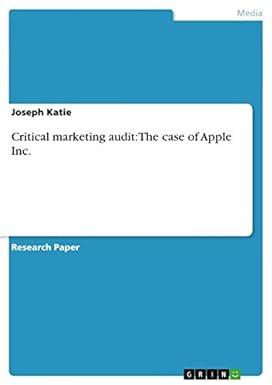Question
Lundberg Corporation's most recent balance sheet and income statement appear below: Statement of Financial Position December 31, Year 2 and Year1 (in thousands of dollars)
Lundberg Corporation's most recent balance sheet and income statement appear below: Statement of Financial Position December 31, Year 2 and Year1 (in thousands of dollars) Year 2 Year 1 Assets Current assets: Cash $ 360 $ 490 Accounts receivable 600 480 Inventory 370 510 Prepaid expenses 140 140 Total current assets 1,470 1,620 Plant and equipment, net 3,580 3,320 Total assets $ 5,050 $ 4,940 Liabilities and Stockholders' Equity Current liabilities: Accounts payable $ 518 $ 430 Accrued liabilities 115 180 Notes payable, short term 360 220 Total current liabilities 993 830 Bonds payable 515 630 Total liabilities 1,508 1,460 Stockholders' equity: Preferred stock, $100 par value, 10% 1,450 1,450 Common stock, $1 par value 720 720 Additional paid-in capital--common stock 790 790 Retained earnings 582 520 Total stockholders' equity 3,542 3,480 Total liabilities & stockholders' equity $ 5,050 $ 4,940 Income Statement For the Year Ended December 31, Year 2 (in thousands of dollars) Sales (all on account) $ 6,270 Cost of goods sold 4,080 Gross margin 2,190 Selling and administrative expense 1,336 Net operating income 854 Interest expense 44 Net income before taxes 810 Income taxes (30%) 243 Net income $ 567 Dividends on common stock during Year 2 totaled $360 thousand. Dividends on preferred stock totaled $145 thousand. The market price of common stock at the end of Year 2 was $9.62 per share. Required: Compute the following for Year 2: a. Gross margin percentage. (Round your answer to 1 decimal place.) Gross margin percentage % b. Earnings per share of common stock. (Round your answer to 2 decimal places.) Earnings per share $ c. Price-earnings ratio. (Round your intermediate calculations to 2 decimal places and final answer to 1 decimal place.) Price-earnings ratio times d. Dividend payout ratio. (Round your intermediate calculations to 2 decimal places and final answer to 1 decimal place.) Dividend payout ratio % e. Dividend yield ratio. (Round your answer to 2 decimal places.) Dividend yield ratio % f. Return on total assets. (Round your intermediate calculations and final answer to 2 decimal places.) Return on total assets % g. Return on common stockholders' equity. (Round your answer to 2 decimal places.) Return on common stockholders' equity % h. Book value per share. (Round your answer to 2 decimal places.) Book value per share $ i. Working capital. Working captial $ j. Current ratio. (Round your answer to 2 decimal places.) Current ratio k. Acid-test ratio. (Round your answer to 2 decimal places.) Acid-test ratio l. Accounts receivable turnover. (Round your answer to 2 decimal places.) Accounts receivable turnover m. Average collection period. (Assume 365 days a year and round your answer to 1 decimal place.) Average collection period days n. Inventory turnover. (Round your answer to 2 decimal places.) Inventory turnover o. Average sale period. (Assume 365 days a year and round your answer to 1 decimal place.) Average sale period days p. Times interest earned. (Round your answer to 2 decimal places.) Times interest earned q. Debt-to-equity ratio. (Round your answer to 2 decimal places.) Debt-to-equity ratio
Step by Step Solution
There are 3 Steps involved in it
Step: 1

Get Instant Access to Expert-Tailored Solutions
See step-by-step solutions with expert insights and AI powered tools for academic success
Step: 2

Step: 3

Ace Your Homework with AI
Get the answers you need in no time with our AI-driven, step-by-step assistance
Get Started


